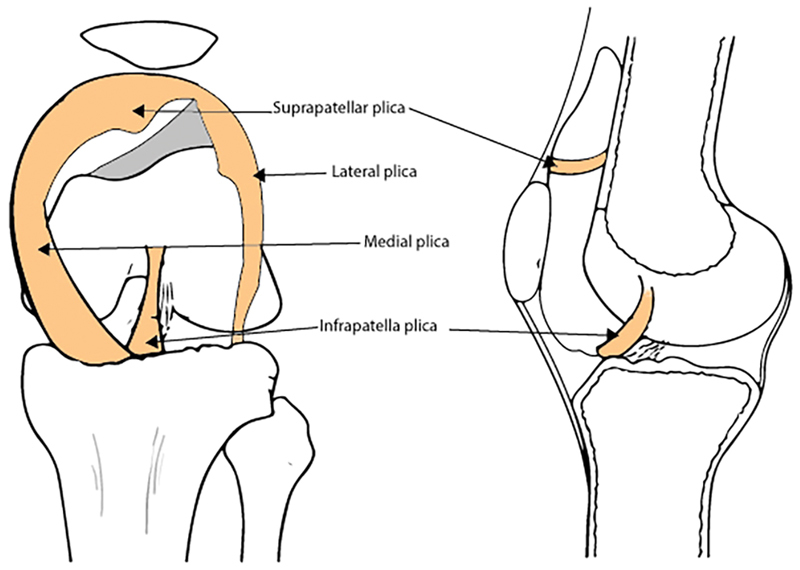Plica Syndrome: Difference between revisions
No edit summary |
No edit summary |
||
| Line 2: | Line 2: | ||
{{Condition | {{Condition | ||
|quality=Stub | |quality=Stub | ||
| | |image=Knee plicae.jpg | ||
|caption=The location of the synovial plica in the knee joint | |||
|synonym=Synovial plica syndrome | |||
|pathophysiology=Fibrotic taut plica | |pathophysiology=Fibrotic taut plica | ||
|clinicalfeatures=Anterior and medial knee pain | |clinicalfeatures=Anterior and medial knee pain | ||
| Line 9: | Line 11: | ||
|treatment=Activity modification, analgesia, corticosteroid injection | |treatment=Activity modification, analgesia, corticosteroid injection | ||
}} | }} | ||
'''Plica Syndrome''' is a painful knee condition due to a pathological synovial plica. | |||
== Anatomy == | == Anatomy == | ||
The plicae are embryonic remnants of the normal joint compartment separations. | The plicae are embryonic remnants of the normal joint compartment separations that fold inwards and are present in most knees. They are normally a thin (almost transparent), vascular, and pliable band of tissue. They originate from the synovial lining and cross the [[Synovial Joint|synovial joint]]. | ||
Plicae can be found int he suprapatellar, medial, infrapatellar, or lateral compartments of the [[Knee Joint|knee]] | Plicae can be found int he suprapatellar, medial, infrapatellar, or lateral compartments of the [[Knee Joint|knee]] | ||
| Line 32: | Line 35: | ||
=Treatment= | =Treatment= | ||
Activity modification, analgesia, corticosteroid injection | Activity modification, analgesia, corticosteroid injection | ||
==Further Reading== | |||
*{{Open access icon}} {{#pmid:28825013}} | |||
[[Category:Knee and Leg Conditions]] | |||
{{References}} | {{References}} | ||
{{Reliable sources}} | {{Reliable sources}} | ||
Revision as of 17:21, 25 April 2022
Plica Syndrome is a painful knee condition due to a pathological synovial plica.
Anatomy
The plicae are embryonic remnants of the normal joint compartment separations that fold inwards and are present in most knees. They are normally a thin (almost transparent), vascular, and pliable band of tissue. They originate from the synovial lining and cross the synovial joint.
Plicae can be found int he suprapatellar, medial, infrapatellar, or lateral compartments of the knee
Pathophysiology
A plica can become pathological as a result of direct blunt trauma to the knee, repetitive injury, or from irritation from another knee abnormality such as osteochondritis dissecans or inflammatory arthritis. This results in it becoming fibrotic, avascular, and taut. This taut nonpliable band can rub over the medial femoral condyle or it can become trapped between the patella and femoral condyle.
The medial plica is most commonly symptomatic.
Clinical Features
Anterior and medial knee pain that occurs after direct trauma or a repetitive injury. The pain is usually worse with sitting for long periods (called the theatre sign), squatting, kneeling, or walking upstairs. There may be a clicking sensation with knee flexion.
On examination for medial plica syndrome there may be slight swelling medial to the patellar margin. Flex the knee to 90 degrees and there may be a firm tender ridge of tissue that runs either parallel or at a slight oblique angle to the medial border of the patella.
Medial patellar plica test: The patient is supine. Apply pressure over the inferomedial border of the patellofemoral joint. This pushes the plica between the medial patella and medial femoral condyle. Maintain the pressure and passively flex the knee from 0 to 90 degrees. A positive test is provocation of pain at this extended position that is relieved at 90 degrees of flexion.
Investigations
Imaging is poor at visualising this condition. MRI is done sometimes to exclude mimics.
Treatment
Activity modification, analgesia, corticosteroid injection
Further Reading
 Lee et al.. Synovial Plica Syndrome of the Knee: A Commonly Overlooked Cause of Anterior Knee Pain. Surgery journal (New York, N.Y.) 2017. 3:e9-e16. PMID: 28825013. DOI. Full Text.
Lee et al.. Synovial Plica Syndrome of the Knee: A Commonly Overlooked Cause of Anterior Knee Pain. Surgery journal (New York, N.Y.) 2017. 3:e9-e16. PMID: 28825013. DOI. Full Text.
Literature Review
- Reviews from the last 7 years: review articles, free review articles, systematic reviews, meta-analyses, NCBI Bookshelf
- Articles from all years: PubMed search, Google Scholar search.
- TRIP Database: clinical publications about evidence-based medicine.
- Other Wikis: Radiopaedia, Wikipedia Search, Wikipedia I Feel Lucky, Orthobullets,



